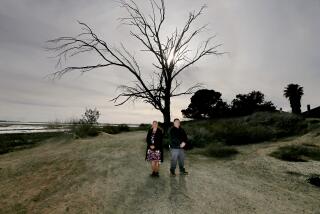Shaman and Freedom-Fighter Led Indiansâ Mission Revolt
Hidden in the padresâ 200-year-old scrawlings at four California missions are the brief records of a native Californian, a woman depicted by the Spanish and even by her own people as a seductress, a sorceress and a witch--but by others as a freedom-fighter.
Toypurina was no ordinary woman. She was a shaman, the daughter of a shaman and a co-leader in a revolt against the San Gabriel Mission in 1785.
Although she was exiled for her role in the rebellion, her baptismal records would later be found in the registry of the very mission she tried to destroy.
In 1771, Toypurina was a 10-year-old girl in the nearby village of Jachivit. But her life drastically changed after the Spanish missionaries and soldiers arrived that year and claimed the land of what would become the San Gabriel Mission. After a soldier raped the wife of an Indian chief, the chief protested. He was killed, and his head displayed on a pole as an example to others.
Growing up outside the mission walls, Toypurina watched nearly a thousand of her neighbors lured into captive Christianity by the clothes, food and blankets the padres offered to converts.
She grew indignant as she saw them gradually confined to the mission and forced into farm work. She witnessed the population of âneophytes,â as the Indian converts were called, dying from syphilis and other diseases, and being chained and beaten when they tried to escape.
Another Indian shared her anger. Nicolas Jose, a disgruntled neophyte working inside the mission, had been in trouble a few years before when, in a jealous rage, he plotted to kill a soldier who had flirted with his fiancee. Then, when the Franciscans refused to let him perform his native dances because they were considered pagan, he decided to kill them.
He persuaded Toypurina to rally her magic skills against the hated padres, Antonio Cruzado and Miguel Sanchez, and Toypurina cast a death spell on them. He also persuaded her to use her influence to recruit others in a revolt against the soldiers.
For the 24-year-old Toypurina, inspiring her own tribe was easy, for her brother was chief. But winning the support of the other villages is what may attest to her fame as a shaman, and to her leadership.
But when the corporal of the guard, Jose Maria Verdugo, got wind of the impending attack from another soldier who overheard some Indians talking about the plan, Verdugo and the padres carefully calculated a counter-plot.
On the moonless night of Oct. 25, 1785, Toypurina, two chiefs and dozens of warriors from about six villages scaled the mission walls. Nicolas Jose was waiting inside to lead them into the padresâ spartan quarters, to show them that Toypurinaâs mystic powers had killed the padres.
But the real padres were in the chapel, praying for the rebelsâ souls. The men in the padresâ rooms were in reality two soldiers, dressed in gray Franciscan robes, their cowls pulled over their faces, playing dead. That is what Toypurina and her group saw, by candlelight, as they entered.
âSantiago!â--St. James, the patron saint of Spain--yelled one soldier as he sprang to his feet, scaring the wits out of the Indians. More armed soldiers came rushing into the room.
Shocked at the trick, many warriors dropped their weapons and fled. Toypurina and 20 others were seized and thrown in the mission jail. Their trial began on Jan. 3, 1786, more than two months later, so the governor, Pedro Fages, had time to reach the San Gabriel Mission from Monterey.
Hoping to get to the bottom of the plot, Fages drew up 10 questions to ask each prisoner. Jose Maria Pico, the father of Californiaâs last Mexican governor Pio Pico, knew the language of the natives and acted as interpreter. He was the soldier who, hidden behind a sycamore, had eavesdropped on the plotters.
Both chiefs testified that they had no quarrel with the soldiers or padres, but had been tricked by âthat serpent-tongued witch,â with her âsweet words and hidden threats.â Then Nicolas Jose admitted bribing Toypurina with glass beads, and he took responsibility for masterminding the plot.
But it was Toypurina who proved to be the star witness.
As she entered the room with her hands tied behind her back, she immediately kicked over the stool on which she was expected to sit. Standing erect and proud, she stared fiercely at her judges.
Fages liked her spunkiness. (Maybe she reminded him of another strong-willed Indian woman--the one he was having an affair with when his wife caught them, which created a vast scandal.)
Angrily, Toypurina lashed out in her defense: âI hate the padres and all of you, for living here on my native soil, for trespassing upon the land of my forefathers and despoiling our tribal domains.â
Her eyes filled with rage as she justified her actions: âI came to inspire the dirty cowards [Indians] to fight, and not to quail at the sight of Spanish sticks that spit fire, and not retch at the evil smell of gunsmoke--and be done with you white invaders!â
Her antipathy to other Indians stemmed from her frustration with them for not only flocking to the mission for the goods that the missionaries offered, but for displacing existing Indians and use of the land, according to Steven Hackel, a professor at Oregon State University. His article, âIndian Testimony and the Mission San Gabriel Uprising,â is to be published in the Journal of Ethnohistory later this year.
The next day, Fages ordered Nicolas Jose and the two chiefs to be transported in irons to the San Diego Presidio. Toypurina was to remain in custody at the San Gabriel Mission, while officials in Mexico City read the trial transcript and determined the punishment for them all.
The other 17 rebels were set free after receiving 20 lashes each, âto show them that the sorceries and incantations of the woman Toypurina are powerless in the face of the True Faith,â Fages said.
On March 8, 1787, still in jail more than a year after her trial, Toypurina was baptized with a group of others at the San Gabriel Mission by the same padre Sanchez she tried to kill. He gave her the name âRegina,â meaning queen. No one knows whether she converted willingly. Her Indian husband refused to convert.
That same year, Fages wrote the âCode of Conductâ for the soldiers guarding the mission, warning them to treat the Indians justly and with respect and caution. His regard for Toypurina was evident in his plea to Mexico City for leniency for her.
At last, more than two years after the failed plot, the orders for punishment arrived. Nicolas Jose would be exiled to Monterey for six years at half-rations, without pay and in shackles, then transferred to a nearby mission, far from his family. The two chiefs were released to their villages and kept under surveillance.
Toypurinaâs Indian marriage was annulled before she was exiled to the San Carlos Borromeo mission of Carmel. There, in 1789, the 28-year-old woman found companionship with a soldier named Manuel Montero. Fages attended the wedding celebration of the headstrong woman he once considered a noble savage.
Ten years later, after bearing four children, Toypurina died and was buried at Mission San Juan Bautista on May 22, 1799, near Carmel.
Today, a stone mound like one the Gabrielinos would have raised up as a place of prayer--this modern one created by award-winning mural artist Judy Baca--stands as a tribute to Toypurina at the Metrolink stop in Baldwin Park.
More to Read
Sign up for Essential California
The most important California stories and recommendations in your inbox every morning.
You may occasionally receive promotional content from the Los Angeles Times.










